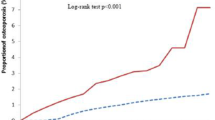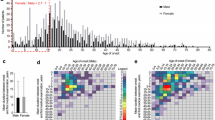Abstract
Keloids is a fibroproliferative disease. The incidence of keloids among Asians has not been thoroughly studied. The objective of this study is to determine the incidence of keloids in Taiwan, which mainly consists of ethnic Chinese. Furthermore, we want to determine the comorbidity rate of other fibrosis-related diseases among keloid patients. This study was based on the National Health Insurance Research Database, which contains the data of 1 million randomly selected patients. Multivariate logistic regression analyses were employed to estimate the relative odds of keloids as a function of fibrosis-related diseases. The annual keloid incidence rate in Taiwan was 0.15 % for the general population. With a 1.33 ratio, women outnumbered men. Women with uterine leiomyoma have a 2.25-fold greater risk of keloids, compared with women without leiomyoma. We concluded that keloid incidence in Taiwan is approximately 0.15 %. Women with leiomyoma have a greater risk of keloids, this implicates that both diseases share a common etiopathological pathway.

Similar content being viewed by others
References
Abergel RP, Pizzurro D, Meeker CA, Lask G, Matsuoka LY, Minor RR, Chu ML, Uitto J (1985) Biochemical composition of the connective tissue in keloids and analysis of collagen metabolism in keloid fibroblast cultures. J Invest Dermatol 84(5):384–390
Alhadya SM, Sivanantharajah K (1969) Keloids in various races a review of 175 cases. Plast Reconstr Surg 44(6):564–566
Bae JM, Ha B, Lee H, Park CK, Kim HJ, Park YM (2012) Prevalence of common skin diseases and their associated factors among military personnel in Korea: a cross-sectional study. J Korean Med Sci 27(10):1248–1254
Barrett J (1973) Keloid. In: Birth Defect Compendium. Williams and Wilken Company, Baltimore
Bayat A, Arscott G, Ollier WE, McGrouther DA, Ferguson MW (2005) Keloid disease: clinical relevance of single versus multiple site scars. Br J Plast Surg 58(1):28–37
Bayat A, Bock O, Mrowietz U, Ollier WE, Ferguson MW (2004) Genetic susceptibility to keloid disease: transforming growth factor beta receptor gene polymorphisms are not associated with keloid disease. Exp Dermatol 13(2):120–124
Brown JJ, Bayat A (2009) Genetic susceptibility to raised dermal scarring. Br J Dermatol 161(1):8–18
Brown JJ, Ollier WE, Thomson W, Bayat A (2008) Positive association of HLA-DRB1*15 with keloid disease in Caucasians. Int J Immunogenet 35(4–5):303–307
Carrino DA, Mesiano S, Barker NM, Hurd WW, Caplan AI (2012) Proteoglycans of uterine fibroids and keloid scars: similarity in their proteoglycan composition. Biochem J 443(2):361–368
Char F (1971) Ehlers-Danlos syndrome. Birth Defects Orig Artic Ser 7(8):300–302
Chen GY, Cheng YW, Wang CY, Hsu TJ, Hsu MM, Yang PT, Chen WC (2008) Prevalence of skin diseases among schoolchildren in Magong, Penghu, Taiwan: a community-based clinical survey. J Formos Med Assoc 107(1):21–29
Cheng CL, Kao YHY, Lin SJ, Lee CH, Lai ML (2011) Validation of the National Health Insurance Research Database with ischemic stroke cases in Taiwan. Pharmacoepidemiol Drug Saf 20(3):236–242
Chin GS, Liu W, Peled Z, Lee TY, Steinbrech DS, Hsu M, Longaker MT (2001) Differential expression of transforming growth factor-beta receptors I and II and activation of Smad 3 in keloid fibroblasts. Plast Reconstr Surg 108(2):423–429
Cosman B, Crikelair GF, Ju DMC, Gaulin JC, Lattes R (1961) The surgical treatment of keloids. Plast Reconstr Surg 27(4):335–358
De Nicola A, Mancuso P, Valdmanis V (2013) Quality and health care performance in the Italian regions. Munich Personal RePEc Archive. http://mpra.ub.uni-muenchen.de/50495/. Accessed 15 Jul 2014
Fisher ES, Whaley FS, Krushat WM, Malenka DJ, Fleming C, Baron JA, Hsia DC (1992) The accuracy of Medicare’s hospital claims data: progress has been made, but problems remain. Am J Public Health 82(2):243–248
Flake GP, Andersen J, Dixon D (2003) Etiology and pathogenesis of uterine leiomyomas: a review. Environ Health Perspect 111(8):1037–1054
Hambrick GW Jr, Carter DM (1966) Pachydermoperiostosis. Touraine-Solente-Gole syndrome. Arch Dermatol 94(5):594–607
Hoekstra AV, Sefton EC, Berry E, Lu Z, Hardt J, Marsh E, Yin P, Clardy J, Chakravarti D, Bulun S, Kim JJ (2009) Progestins activate the AKT pathway in leiomyoma cells and promote survival. J Clin Endocrinol Metab 94(5):1768–1774
Iwahashi M, Muragaki Y (2011) Increased type I and V collagen expression in uterine leiomyomas during the menstrual cycle. Fertil Steril 95(6):2137–2139
James WD, Berger TG, Butler DF, Tuffanelli DL (1984) Nodular (keloidal) scleroderma. J Am Acad Dermatol 11(6):1111–1114
Ketchum LD, Cohen IK, Masters FW (1974) Hypertrophic scars and keloids. A collective review. Plast Reconstr Surg 53(2):140–154
Kiyota Y, Schneeweiss S, Glynn RJ, Cannuscio CC, Avorn J, Solomon DH (2004) Accuracy of medicare claims-based diagnosis of acute myocardial infarction: estimating positive predictive value on the basis of review of hospital records. Am Heart J 148(1):99–104
Ko CW, Dominitz JA, Green P, Kreuter W, Baldwin LM (2011) Accuracy of medicare claims for identifying findings and procedures performed during colonoscopy. Gastrointest Endosc 73(3):447–453
Lee TY, Chin GS, Kim WJ, Chau D, Gittes GK, Longaker MT (1999) Expression of transforming growth factor beta 1, 2, and 3 proteins in keloids. Ann Plast Surg 43(2):179–184
Leppert PC, Catherino WH, Segars JH (2006) A new hypothesis about the origin of uterine fibroids based on gene expression profiling with microarrays. Am J Obstet Gynecol 195(2):415–420
Lin CC, Lai MS, Syu CY, Chang SC, Tseng FY (2005) Accuracy of diabetes diagnosis in health insurance claims data in Taiwan. J Formos Med Assoc 104(3):157–163
Lu WS, Wang JF, Yang S, Xiao FL, Quan C, Cheng H, Wang PG, Zhang AP, Cai LQ, Zhang XJ (2008) Association of HLA-DQA1 and DQB1 alleles with keloids in Chinese Hans. J Dermatol Sci 52(2):108–117
Marneros AG, Norris JE, Watanabe S, Reichenberger E, Olsen BR (2004) Genome scans provide evidence for keloid susceptibility loci on chromosomes 2q23 and 7p11. J Invest Dermatol 122(5):1126–1132
Moustafa MF, Abdel-Fattah MA, Abdel-Fattah DC (1975) Presumptive evidence of the effect of pregnancy estrogens on keloid growth. Case report. Plast Reconstr Surg 56(4):450–453
Oluwasanmi JO (1974) keloids in the African. Clin Plast Surg 1(1):179–195
Phan TT, Lim IJ, Aalami O, Lorget F, Khoo A, Tan EK, Mukhopadhyay A, Longaker MT (2005) Smad3 signalling plays an important role in keloid pathogenesis via epithelial-mesenchymal interactions. J Pathol 207(2):232–242
Pohlers D, Brenmoehl J, Loffler I, Muller CK, Leipner C, Schultze-Mosgau S, Stallmach A, Kinne RW, Wolf G (2009) TGF-beta and fibrosis in different organs—molecular pathway imprints. Biochim Biophys Acta 1792(8):746–756
Ramakrishnan KM, Thomas KP, Sundararajan CR (1974) Study of 1,000 patients with keloids in South India. Plast Reconstr Surg 53(3):276–280
Rockwell WB, Cohen IK, Ehrlich HP (1989) Keloids and hypertrophic scars: a comprehensive review. Plast Reconstr Surg 84(5):827–837
Shih B, Bayat A (2010) Genetics of keloid scarring. Arch Dermatol Res 302(5):319–339
Shih B, Bayat A (2012) Comparative genomic hybridisation analysis of keloid tissue in Caucasians suggests possible involvement of HLA-DRB5 in disease pathogenesis. Arch Dermatol Res 304(3):241–249
Shoemaker JF (1901) A practical treatise on disease of the skin. Appleton, New York
Siraganian PA, Rubinstein JH, Miller RW (1989) Keloids and neoplasms in the Rubinstein-Taybi syndrome. Med Pediatr Oncol 17(6):485–491
Stewart EA, Friedman AJ, Peck K, Nowak RA (1994) Relative overexpression of collagen type I and collagen type III messenger ribonucleic acids by uterine leiomyomas during the proliferative phase of the menstrual cycle. J Clin Endocrinol Metab 79(3):900–906
Syed F, Bagabir RA, Paus R, Bayat A (2013) Ex vivo evaluation of antifibrotic compounds in skin scarring: EGCG and silencing of PAI-1 independently inhibit growth and induce keloid shrinkage. Lab Invest 93(8):946–960
Uitto J, Perejda AJ, Abergel RP, Chu ML, Ramirez F (1985) Altered steady-state ratio of type I/III procollagen mRNAs correlates with selectively increased type I procollagen biosynthesis in cultured keloid fibroblasts. Proc Natl Acad Sci USA 82(17):5935–5939
Vargas L Jr (1943) Attempt to induce formation of fibroids with estrogen, in the castrated female rhesus monkey. Bull Johns Hopkins Hosp 73(1):23–28
Walker SL, Shah M, Hubbard VG, Pradhan HM, Ghimire M (2008) Skin disease is common in rural Nepal: results of a point prevalence study. Br J Dermatol 158(2):334–338
Yan X, Gao JH, Chen Y, Song M, Liu XJ (2007) Preliminary linkage analysis and mapping of keloid susceptibility locus in a Chinese pedigree. Zhonghua Zheng Xing Wai Ke Za Zhi 23(1):32–35
Yang YC, Cheng YW, Lai CS, Chen W (2007) Prevalence of childhood acne, ephelides, warts, atopic dermatitis, psoriasis, alopecia areata and keloid in Kaohsiung County, Taiwan: a community-based clinical survey. J Eur Acad Dermatol Venereol 21(5):643–649
Acknowledgments
The authors wish to thank Mr. Li-Zhou Yeh for his expert assistance with the structured query language programming related to the NHIRD.
Conflict of interest
None.
Author information
Authors and Affiliations
Corresponding author
Rights and permissions
About this article
Cite this article
Sun, LM., Wang, KH. & Lee, YC.G. Keloid incidence in Asian people and its comorbidity with other fibrosis-related diseases: a nationwide population-based study. Arch Dermatol Res 306, 803–808 (2014). https://doi.org/10.1007/s00403-014-1491-5
Received:
Revised:
Accepted:
Published:
Issue Date:
DOI: https://doi.org/10.1007/s00403-014-1491-5




